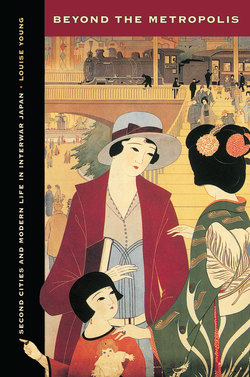Читать книгу Beyond the Metropolis - Louise Young - Страница 11
На сайте Литреса книга снята с продажи.
ОглавлениеACKNOWLEDGMENTS
Among the great pleasures of doing research in Japan are the friends one accumulates along the way. This study took me to four cities and introduced me to wonderful communities of local historians and archivists in each. By remarkable good fortune, I embarked on my research around the centennial of the incorporation of most of Japan’s second cities in the 1889 administrative reforms that established the “city, town, village” system. This meant that many municipal governments were engaged in production of centennial histories. With the characteristic generosity that greets foreign researchers, local archivists opened their collections to me and shared materials they had gathered for their own works-in-progress. They also offered their wisdom, insights, and local knowledge. Without their gracious collaboration, I could never have done this study; I acknowledge this debt with heartfelt gratitude.
In Sapporo, Aiuchi Masako and Aiuchi Toshikazu opened their home to me and introduced me to their extensive network of local historians. Yamada Hirotaka made numerous key introductions to local study groups. The Sapporo Municipal History Office extended a warm welcome and generously allowed me access to the materials their history group had assembled to write the superb New History of Sapporo. I benefited from the assistance of Endō Tatsuhiko at the Hokkaido Prefectural Archives, and at the Sapporo Municipal History Office, from Enomoto Yōsuke, Hayashi Mikitada, Ishida Takehiko, and Konno Yukari. Special thanks are due Nishida Hideko and Takagi Hiroshi, who both spent hours of their time with me. In Niigata, Furumaya Tadao and Yoshii Ken’ichi were both generous and helpful, as was Minami Ken’ichi. Itō Sukeyuki at the Niigata City Archives provided good company and good advice in equal measure. In Okayama, Sakamoto Jūji gave me excellent research tips and a stack of his wonderful books on the local social movement; Arima Nobutsune, Ōta Ken’ichi, and Kandachi Harushige were all great resources. In Kanazawa Motoyasu Hiroshi at the Ishikawa Prefectural Museum of History provided a treasure trove of materials from the museum archives and a memorable architectural tour of the hidden history of modern Kanazawa. Chiku Kakugyō and Hashimoto Tetsuya also generously shared their knowledge of local history; and Kamura Kōsaku offered guidance at the Ishikawa Prefectural Library. My apologies to anyone I inadvertently omitted from this list because of a failure of memory or record keeping. I am extraordinarily grateful for the opportunity to have met the wonderful communities of local historians in what I have come to think of as “my four cities” and for their generous assistance in my research.
This book was begun while I worked at New York University and completed after I moved to the University of Wisconsin-Madison. Both institutions provided generous financial support: at NYU through a Freeman Foundation grant and the Research Challenge Fund; at the UW through the Graduate School, the Vilas Foundation, and the Institute for Research in Humanities. Colleagues at both schools have shaped my thinking about cities and urban culture. At NYU I benefited in particular from conversations with Ada Ferrer, Manu Goswami, Harry Harootunian, Walter Johnson, Rebecca Karl, Yanni Kotsonis, and Joanna Waley-Cohen. At the UW-Madison, David Lehene, Richard Miller, Emiko Ohnuki-Tierney, Jim Raymo, Steve Ridgely, Ben Singer, Steve Stern, and Sarah Thal read portions of the work in progress and provided excellent feedback.
Financial support for research in Japan came from the Social Science Research Council, the National Endowment for Humanities, and the Fulbright Foundation, where Itō Jinko and Iwata Mizuho offered both timely assistance and good humor. I offer my thanks to Hasebe Hiroshi and the staff at Seikei University Center for Asia and Pacific Studies for providing accommodation and an institutional affiliation during one of my research visits, and to Barbara Satō for arranging the whole visit. I also benefited from a semester in residence at the Kyoto University Institute for Research in Humanities, which Yamamuro Shin’ichi helped set up, and where he and Kagotani Naoto, Mizuno Naoki, Takagi Hiroshi, and Yamamoto Yūzo provided a congenial intellectual community.
Other friends and colleagues whose critical support is gratefully acknowledged include Kim Brandt, Geoffrey Chambers, John Dower, Eguchi Keiichi, Jim Fujii, Laura Hein, Igarashi Takeshi, Mark Jones, Naitō Sachiko, Naitō Tsuneiji, Nishimura Shigeo, Nishimura Takako, Okabe Makio, Okamoto Kōichi, John Ratté, Lou Ratté, Jordan Sand, Barbara Satō, and Satō Kazuki.
Melissa Dale, Ken Kawashima, Kimiko Osawa, Rebecca Shearier, and Ayako Yoshimura provided research assistance at different stages of the project. I wish to also thank the wonderful editorial staff at University of California Press, including Niels Hooper and Kim Hogeland, as well as Daniel Rivero at the Weatherhead Institute.
Nan Enstad, Carol Gluck, Andrew Gordon, Crawford Young, and an anonymous reader from UC Press read the entire manuscript at the penultimate stage. Their comments were invaluable in helping me tighten and refine the central argument.
A special debt is owed my mother, Rebecca Young, whose irrepressible enthusiasm for all things urban and whose keen appreciation for the aesthetics of interwar culture provided inspiration for this project. My work on Beyond the Metropolis coincided with her ten-year battle with cancer; her grace and courage sustained me, always. I dedicate this book to her memory with love and admiration.
